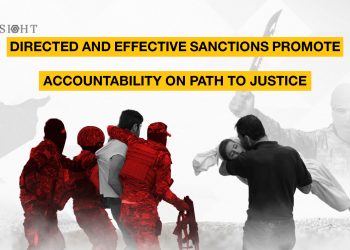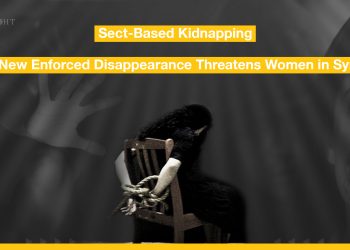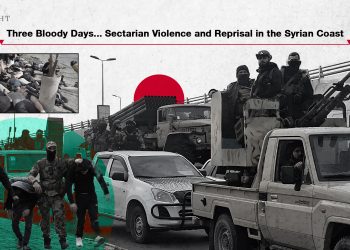Rights to Housing, Land, Water and Livelihood
Introduction
Throughout 13 years of conflict in Syria, around 2.9 million displaced persons in northeast and
northwest Syria have been forced to live with displacement, dispossession, looting and theft.
They are compelled to seek alternatives for housing, work and income, instead of the displaced
persons returning to their properties, holding the perpetrators accountable, or redressing their
costs, loss and damage.
It is not possible to provide comprehensive figures to depict the sheer volume of these
violations and losses in northern Syria, because the causes and circumstances of the conflict
remain in place. The same military entities continue to control and threaten the victims in a
territory disputed by various parties, and where all types of violations are repeated.
However, based on the monitoring efforts of the Insight Organisation, evidence can be shared
recounting violations of the local population’s universal human rights to livelihood, land,
housing and water. Despite the plurality of perpetrators, these violations form a common and
systematic policy in certain areas where various foreign-backed militias operate. The reader will
appreciate that, because of the inherent difficulties on gathering information, figures provided
here for land area, extent of damage and numbers of affected persons are estimated.
The pattern of these violations is not linear. Nor is the presence of the military actors
consistent, stable or predictable; they are constantly vying with each other for territorial
control. Caught in the middle, the diverse civilian population nonetheless endures the common
deprivation that is the outcome of such geostrategic competition over spheres of influence, the
land and its people.
For the purpose of presenting a coherent picture from this mosaic, this presentation largely
pursues a chronological approach. To develop a current snapshot of the ongoing situation, this
report covers only the most-recent period (2023–24). Partial though this documentary record
may be, it gives the reader a glimpse into what everyday Syrians are forced to endure at the
hands and arms of foreign occupants of their territory.
2023
Iranian factions have seized properties and forcibly evicted inhabitants
Armed groups loyal to Iran have seized civilian homes in Dhayr al-Zawr city and its region,
converting them into military headquarters or religious and cultural centers for themselves.
Incidents in 2023 include the following:
Iran-backed militias force six families to vacate their homes in the town of al-Quriyah, in the
Dhayr al-Zawr countryside. These Iranian forces subjected the inhabitants to threats of forced
eviction and dispossession under the pretext of the location’s strategic importance. Among
these victims are:
Hussain al-Mansour’s household left their home forcibly, only to learn that Iranian
Revolutionary Guard units had installed a missile launching pad in his house.
Ahmad al-Hamad and his family left their house in al-Mayadin, in the Dhayr al-Zawr
countryside, after Revolutionary Guard Corps (IRGC) units took up residence in the
Figure 1: Map of the military situation in Syria as of October 2024. Source: Wikipedia. See detailed map here.
neighborhood,repeatedly provoking and harassing him. This abuse included accusing him of
terrorism and harassing girls in the neighborhood. After al-Hamads left their house, Ahmad
learned that it had been turned into a weapons warehouse. He objected because the occupiers
led him to believe that the militants needed the house to live in. But he retracted his objection
after being arbitrarily arrested for two days under the threat of newly fabricate charges against
him.
Jabir al-Amash, from al-Mayadin, left his house and headed to Dhayr al-Zawr city after Iranian
militants repeatedly sought refuge there during US raids on their sites.
Raghib al-Salim, also from al-Mayadin, was forced, along with the majority of the residents of
his neighborhood (Tamu neighborhood)in the southern part of the city. They had to vacate
their homes to accommodate foreign (Afghan) fighters working with the IRGC. He says they
were forced to leave because the militants removed the walls between the houses, and
opened holes between them to hide ammunition from enemy aircraft. That made the lives of
the families impossible, and most of them resorted to living in rented houses in other
neighborhoods.
Zain al-Muhammad and his family fled from al-Mayadin for fear of arrest after they refused
to “convert to Shiism,” and headed to the town of al-Tayyana, on the opposite bank of the
Euphrates River.
Meanwhile, the pro-Iran factions opened at least 13 hussainiyas (prayer and cultural centers)
in various areas of Dhayr al-Zawr.
Muhammad al-`Abd fled from the city of al-Bukamal to the opposite bank of the Euphrates
River, which is under the control of the US-backed Syrian Democratic Forces. That was the
result of an accusation by a leader in the IRGC (an Iraqi national) that al-`Abd gave the
location of their military centers near his home to hostile forces. Al-`Abd said that the
accusation came after he refused several orders to vacate his home so that Iranian
Revolutionary Guard forces could be stationed there.
Some sources in al-Bukamal estimated that the pro-Iran factions (Fatimiyun Brigade, alHashimiyun, al-Nujaba, and the IRGC) systematically and forcibly seized 200 properties,
including homes, lands, and stores in the city of al-Bukamal and the surrounding villages of alSukkariyah, al-Salihiyah, and al-Hamdan.
In another layer of destruction on top of dispossession, unidentified aircraft also destroyed five
buildings in the al-Jam`iyyat neighborhood in central al-Bukamal after IRGC units had converted
them into headquarters and warehouses.
Turkish forces and loyalist factions have violated housing and land rights
Türkiye has continued to exploit the situation of displaced and refugee Syrians to implement
demographic change in `Afrin—which has a Kurdish majority—by settling displaced families that include
10,000 Palestinians who were displaced in Syria and militants involved in the Syrian opposition
factionsloyal to it.
Various external parties have established 29 residential complexes during 2023, 13 of which
were built with the support of Palestinian organizations, four with Kuwaiti support, three with
Saudi support, three with Qatari support, three with the support of the Sawasiyya and Social
Development International organizations in coordination with others, two with the support of
the Turkish Deniz organization, and one with the support of a Gulf businesswoman.
These complexes were distributed near the Kurdish Syrian city of `Afrin and in its adjacent
districts and villages, most notably Jandairis, Shirawa, Sharan, Jabal al-Ahlam, Ghazawiya,
Khalidiya, Kafr Safra, and Kafr Rum. While these developments provided housing for those in
need, they also have contributed to the deliberate anti-Kurd demographic manipulation that
the Turkish occupation has pursued across the region.
The factions of the Syrian National Army (SNA) loyal to Turkey have extorted cash payments
(duties) from the population there. These include payments in to restore a house seized by a
member of the SNA, or a faction affiliated with it, and amounts determined for agricultural land
on the basis of the number of trees on the land, and then again during harvesting.
The SNA has extended this extortion also by levying duties on oil presses and owners of
agricultural tractors and trucks, including those transporting aid to those affected by the 6
February 2023 earthquake.
During the past year, the Insight Organisation monitored the imposition of levies in 114 cases,
51 of which were imposed by the Suleiman Shah faction (also known as al-Amshat), eight cases
by the Military Police and the Sultan Murad faction, and the Hamza Division and the Majd
Corps, each of which imposed levies in five cases, and each of the Eastern Army, Suqur alShamal and the Sham Corps imposed levies in four cases. The same factions carried out 97
seizures of property in the `Afrin and Ra’s al-`Ayn regions, 38 of which were private properties
belonging to elderly men and women.
They cut down 12,566 trees, including 8,831 olive trees, during 2023 in the `Afrin region for the
purpose of selling wood or charcoal. In `Afrin alone, they set fires out of hatred for the
indigenous population, destroying 3,505 trees during the year, on the pretense of making
charcoal for sale.
During 2023, Insight recorded ten cases of random bulldozing and excavation of archaeological
sites in `Afrin, and two in Ra’s al-`Ayn. The factions also damaged and destroyed other historic
and cultural sitesin `Afrin. The destruction affected the Nabi Hori castle and the Jil Khana Yazidi
shrine, the `Ayn Diba and Kovijeh hills, and mountainous areas around the village of Iskan.
Included also were the minaret of the Maidan Akbas mosque, the demolition of the Kakhra
village mosque and the destruction of the Sheikh Hamid (Yazidi)shrine and cemetery near the
village of Qastal.
In the areas controlled by the Syrian Democratic Forces and the Autonomous Administration of
Northern and Eastern Syria (AANES),
Turkish forces escalated their attacks from outside the
borders, using warplanes, drones and artillery shelling during three periods in 2023: January,
October and December. During these attacks, Türkiye targeted 952 sites, 728 of which were
residential areas, 81 were infrastructure facilities, 55 military sites of the Syrian Democratic
Forces, 65 sites of Syrian government forces, and 23 strikes on agricultural lands. This means
that 76% of its targets were residential areas, in addition to other damage to homes near the
other targeted sites.
Türkiye’s control of `Afrin in its 2018 “Operation Olive Branch” led to the displacement of about
300,000 people, some of whom live in five camps in the northern countryside of Aleppo, while
others were distributed in the cities of Aleppo, Hasakah, Qamishli, and al-Malikiyah, or
migrated outside the country after the elements of the Syrian National Army loyal to Türkiye
took control of their homes and fields. Turkey’s control of the Ra’s al-`Ayn and Tal
Abyad areas in its 2019 “Operation Peace Spring” also led to the displacement of
another 300,000 people, who were distributed across the cities of the Syrian Jazira, while a
large number of them remained in camps established by the Autonomous
Administration in al-Hasakah and al-Malikiyah.
Turkey’s control over the Allouk wells that supply the drinking water network in the city
of al-Hasaka and parts of its northern countryside has led to a long-term crisis by
cutting off the water. Consequently, the population has had to rely on unsafe water
transported by tankers at high financial cost and consequences for public health at a time when
epidemics and diseases have spread, and prevention measures depend heavily on clean water.
Türkiye’s control over the flow rate of the Euphrates River its smaller tributaries (most notably
the Khabūr), to 200 cubic meters per second at certain times of the year, as well as exacerbated
the consequences of drought in recent years.
2024
The escalation of Turkish raids at the beginning of 2024 on electrical energy sources and
transformers, oil fields and tanks, and the only cooking gas plant have caused long-term
destruction, impeding inhabitants’ enjoyment of basic services, which the state exercising
effective control over the territory is treaty bound to provide. The year 2024 saw an
accelerated combination of deprivation, denying rights to adequate housing, land, water,
livelihood and other basic civic and environmental goods and services.
Targeting the energy infrastructure
The houses of Qamishli city have not been supplied with public electricity since the Turkish
raids targeted the electricity transformers in mid-January 2024, and the price of bottle of
cooking gas rose from 8,000 Syrian pounds (€.49)
to 150,000 pounds (€9.12). Then the
Autonomous Administration decided to reduce the price to SYP 100,000 (€6.08). Administrators
at the Swaidiyah gas facility estimated the cost of repairing the damage at US$100 million
(€91,575,000).
The Turkish attacks also led to continuous increases in the prices of petroleum derivatives,
including heating fuel, car oils and oil products needed for operating agricultural well pumps.
An assessment of loss and damage to infrastructure from over 580 Turkish attacks on 104 sites
in northern and northeastern Syria between 5 and 9 October 2024, including vital infrastructure
such as power, gas, and water stations and educational facilities, estimated repairs costs at
more than US$1.270 billion (€1.163 billion).
During the current year 2024, the Autonomous Administration raised the price of subsidized
bread and reduced the quantities of fuel sold at a generally reduced price, while reducing the
price of basic crops that it buys from farmers in the region, most notably wheat, then barley
and cotton. The damage affected about three million people of all ethnicities in the
governorates of al-Hasakah, Dhayr al-Zawr and al-Raqqah.
Through its Minister of Defense, Türkiye had threatened to destroy the infrastructure of the
Autonomous Administration region. On 13–15 January 2024, the Turkish Ministry of Defense
published footage of the destruction of facilities, some of which were private factories, claiming
that they were financing the Kurdistan Workers’ Party (PKK), which is banned in Türkiye and
other countries, and to which Türkiye accuses the Syrian Democratic Forces of being linked.
Despite Türkiye’s allegations,the Autonomous Administration did not receive money for public
electricity and water, and most of the destroyed electricity stations were only transformer
stations that did not produce or sell electricity. The same applies to fuel facilities, mills and the
gas plant, which provided services at a subsidized price, meaning that no money was derived
from their operation. (However, no information about oil extraction operations is available.)
Seizing and looting public and private property
In the first half of the current year 2024, the “National Army” factions carried out 16
operations, seizing and looting public and private property, 15 of which were private property
such as agricultural lands, homes and cars. In the `Afrin region alone, the factions carried out 14
cases of seizure and one case in each of the city of `Azaz, in the northern countryside of Aleppo
and Ra’s al-`Ayn. Moreover, during the first half of the current year, Insight has recorded the
felling of 2,020 trees, including 1,263 olive trees, by these factions. The most prominent parties
responsible for destroying forests and farmers’ fields are the factions of the Hamza Division,
Sultan Murad and Malak Shah.
Insight also has monitored acts of vandalism against the Yazidi religious shrine of Mannan,
located near Kafr Janna, in the countryside of `Afrin, where the acts included destroying its
dome and digging inside it.
In addition, government checkpoints in the `Afrin camps have besieged displaced people,
blocking food, fuel and medicine supplies. Those persons moving between different areas of
ruling forces have been subjected also to the theft of their belongings and financial extortion,
especially by the checkpoints of the Syrian government forces’ elite Fourth Armored Division.
More displacement and demographic manipulation
In 2024, Türkiye continued to build housing units for displaced people from other Syrian regions
and resettle opposition militants’ families in the `Afrin region. That has resulted in Turkish
forces seizing public properties and large swaths of land and accelerating Türkiye’s intended
demographic change in `Afrin and its surrounding northern Aleppo countryside. The Insight
team monitored 11 residential complexes, one of which was built with Palestinian support, two
with the support of Britian-based organizations, and the rest with Turkish support.
In 11 August 2024, Syrian government forces and their proxies attacked the Syrian Democratic
Forces in the eastern countryside of Dhayr al-Zawr, which conflict intensified for about a week.
All military parties failed to respect the humanitarian law principle of distinction between
military and civilian objects.
The victims’ families faced difficult times suddenly erupting into conflict. They had family
members killed or injured in the shelling exchanges, with 25 deaths and 28 injuries,their homes
and properties were damaged and were forced to move to nearby areas to wait for military
operations to end.
Witnesses reported that the security points and guards are distributed near the banks of the
river, considering it the contact line between the two areas of influence, but this puts them
close to the houses on the bank, or sometimes in the middle of them.
The attackers’ use of artillery and mortars also meant that the shells fell within an area of
populated housing. This while, in the midst of operations, civilians displaced from both banks of
the Euphrates Riverto safer nearby locations or the Al-Badia areas (desert).
The shelling focused on the villages of al-Dahlah, Abu Hammam, al-Kashkiyah and al-Basira.
Around 100,000 local residentsrisked deprivation of food and drinking water.
Witnesses estimate the number of displaced persons due to the August 2024 conflict in Dhayr
al-Zawr at several thousand residents. 3500 Families displaced to safer nearby locations or the
Al-Badia areas (desert), additional to around 6,500 families did not move far from their homes,
since the armed clashesin 2023, hoping that the fighting would remain in specific areas.
Cumulative violations
Amid this escalation, the extortion of villagers continued. In July and August, al-Amshat militias
imposed duties on Kurdish residents across the Shih/Sheikh al-Hadid district, in the town of
Ma`batli, and several surrounding villages under its control, reportedly collecting the equivalent
of over €730,000.
In the village of Kakhra, where al-Amshat militias demolished a local mosque in 2023 (see
above), women mounted a protest on 15 September 2024 against the continuing extortion and
other abuses by al-Amshat militias, who reportedly had stolen $17,000 from 170 Kurdish
families still residing in the village. Armed al-Amshat militiamen attacked the peaceful
demonstration with sticks, batons, and live bullets, injuring 20 some villagers: women of all
ages, children, and older persons, including a man and a woman each 80 years old.
Conclusion
Many reports by human rights organizations and appeals from civilians in northeastern Syria
indicate the systematic and repeated violations against civilians in northern Syria by all warring
factions, whether loyal to the Syrian government, Iran, the United States military occupation, or
militias loyal to and supported by the Turkish government. Whether through illicitly imposing
levies and duties on the remaining population, or through military means to force civilians to
forcibly displace, loot property, land and housing, to cause demographic change, in addition to
depriving them of access to adequate food and potable water as collective punishment. This
constitutes an obstacle to the return of the displaced and refugees to their homes and the
restoration of their property in accordance with the principle of the right to redress, to achieve
lasting peace and stability.
All governments operating directly or through surrogates on the Syrian people’s territory bear
human rights and humanitarian law obligations, including extraterritorially to avoid violations of
economic, social and cultural rights of the affected population.Whether committed directly or
through proxies, these states’ practices may amount to war crimes and crimes against humanity
in the northern Syria context. All cases of displacement recounted here may amount to forced
evictions. Whether in peacetime, or in situations of conflict, occupation and war, forced
evictions are classified as a ‘gross violation’ of human rights. Being subjected to such a gross
violation, affected persons and households are entitled to reparation, which is comprehensive
package of entitlements, including rights to restitution, return, resettlement, compensation (for
conditions and values impossible to be physically restored), guarantees of nonrepetition and
victims’ satisfaction that the justice—as the Insight Organization seeks3—has been done.
As HLRN previously has submitted in the UN Human Rights Treaty System, all Syrians displaced
and whose sacrosanct human rights have been otherwise defiled—like everyone—enjoy the
treaty-guaranteed right to remedy. Syrians have endured well over a decade of systematic
violationsof their housing, land, water and livelihood in the context of conflict, occupation and
war covered in this report. However, these violations also have a longer scope, and all affected
persons have the same right to remedy. These Syrians, long enduring yet untold costs, loss and
damage, remain our most-urgent priority.
to read the full report, from here: North_Syria_final_EN






